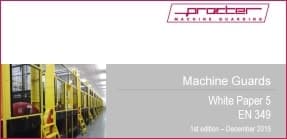Procter Machine Guarding has published a new White Paper that explains the requirements in EN 349, Safety of machinery. Minimum gaps to avoid crushing of parts of the human body.
Compared with some other machinery safety standards, EN 349 (and the UK equivalent BS EN 349) is uncontroversial, simple to understand and straightforward to use. Nevertheless, as this White Paper explains, care has to be taken in its application because there are some pitfalls to avoid.

Procter Machine Guarding has published a new White Paper: EN 349, Explaining the requirements for minimum gaps to avoid crush hazards.
To receive the information you are interested in by return, please just provide a valid email address below.
[contact-form-7 id=”7732″ title=”Downloads Form on Pages” attachment-id=”4557″]
The White Paper highlights a number of issues that machine designers need to consider. For example, the standards listed in clause 2, Normative references, in the current issue EN 349:1993+A1:2008 have now all been superseded, so the White Paper explains which are the equivalent standards now, as well as some of the key differences between these and the superseded standards. In addition, the White Paper stresses the need for a formal risk assessment and raises some important points to watch out for.
A very useful section in the White Paper discusses other factors that machine designers should consider, including Type-C standards relating to specific classes of machine, hazards other than crush hazards, and how to avoid inadvertently introducing new hazards when installing machine guarding.
Copies of the new White Paper, EN 349, Explaining the requirements for minimum gaps to avoid crush hazards, can be downloaded.
To receive the information you are interested in by return, please just provide a valid email address below.
[contact-form-7 id=”7732″ title=”Downloads Form on Pages” attachment-id=”4557″]
Alternatively, request a copy by emailing info@machinesafety.co.uk or telephoning us.
>> Next: Free White Paper: Conveyor guarding explained
>> All Machine Guarding News
